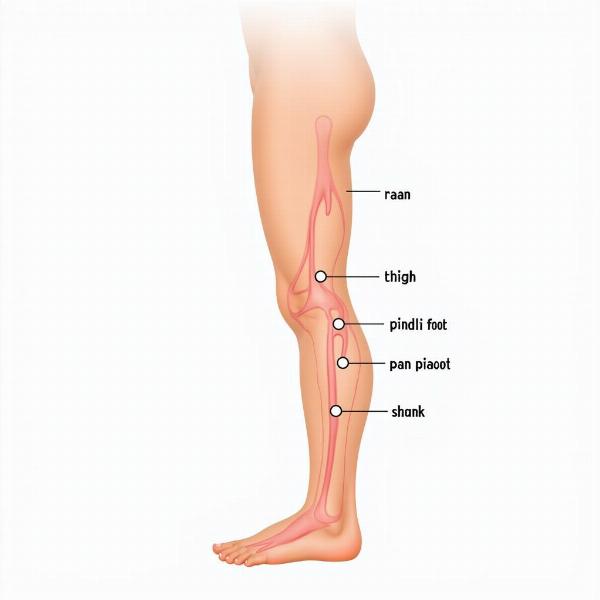Raan meaning in Hindi typically refers to a leg, especially the thigh or the upper part of the leg. Understanding the nuances of this word, however, goes beyond a simple translation. It’s embedded within various cultural, literary, and even culinary contexts in India. This article will delve into the different meanings of “raan” in Hindi, exploring its usage in various contexts and providing a complete understanding of this common word.
Understanding the Core Meaning of Raan
The most basic and commonly understood raan meaning in Hindi is “thigh.” It’s often used in everyday conversations to refer to the upper part of the leg in both humans and animals. For example, you might hear someone say, “Mere raan mein dard hai” (My thigh is paining). This is a straightforward use of the word, indicating a physical location on the body.
Raan in Culinary Context
Beyond its anatomical meaning, “raan” takes on a special significance in Indian cuisine. Here, it refers to a leg of meat, typically lamb, that is marinated and slow-cooked until tender and flavorful. Raan dishes are considered a delicacy, often prepared for special occasions and celebrations. The richness and complexity of the flavors make “raan” a culinary masterpiece. Think of dishes like “Raan Biryani” or “Raan Roast,” where the word clearly signifies a leg of meat. This culinary usage of “raan” is widely recognized across India.
Raan in Literature and Idioms
“Raan” sometimes appears in Hindi literature and idioms, adding depth and color to the language. While less frequent than its anatomical and culinary uses, understanding these contexts provides a richer appreciation of the word. For example, in some rural dialects, “raan” might be used metaphorically to denote strength or power, associating it with the powerful muscles of the thigh.
Variations and Related Terms
Understanding related terms can further clarify the meaning of “raan.” “Paaon” refers to the entire leg, while “pindli” specifies the calf muscle. Recognizing these distinctions helps avoid confusion and ensures accurate communication. Similarly, “jangha” refers to the shank or lower leg.
 Human Leg Anatomy with Hindi Terms
Human Leg Anatomy with Hindi Terms
Raan: A Multifaceted Word
“Raan” is more than just a simple word in Hindi; it’s a term woven into the fabric of Indian language and culture. From describing a part of the body to representing a culinary delight, its meaning shifts depending on the context. By exploring these various facets, we gain a more comprehensive understanding of the richness and depth of the Hindi language.
Conclusion
Understanding the raan meaning in Hindi provides a glimpse into the diverse ways language reflects culture. Whether discussing anatomy, savoring a delicious meal, or encountering the word in literature, recognizing its nuances allows for a richer appreciation of Hindi. Its multifaceted nature demonstrates the complexity and beauty of the language.
FAQ
-
What is the most common raan meaning in Hindi? The most common meaning is “thigh.”
-
How is “raan” used in Indian cuisine? It refers to a leg of meat, typically lamb.
-
What is the difference between “raan” and “paaon”? “Raan” refers to the thigh, while “paaon” refers to the entire leg.
-
Is “raan” used in any Hindi idioms? Yes, although less frequently than its anatomical and culinary uses.
-
What other related terms can help understand “raan”? “Pindli” (calf) and “jangha” (shank) are related terms.
You might also be interested in these articles: praan meaning in hindi, raanjhanaa meaning in hindi
Meaning-Hindi.in is your trusted partner for all your Hindi translation needs. We specialize in various translation services, from business and legal documents to technical manuals and website localization. Our team of expert linguists ensures accurate and culturally sensitive translations. Contact us today for your translation requirements at [email protected] or call us at +91 11-4502-7584. Meaning-Hindi.in is here to bridge the language gap and connect you with the Hindi-speaking world.